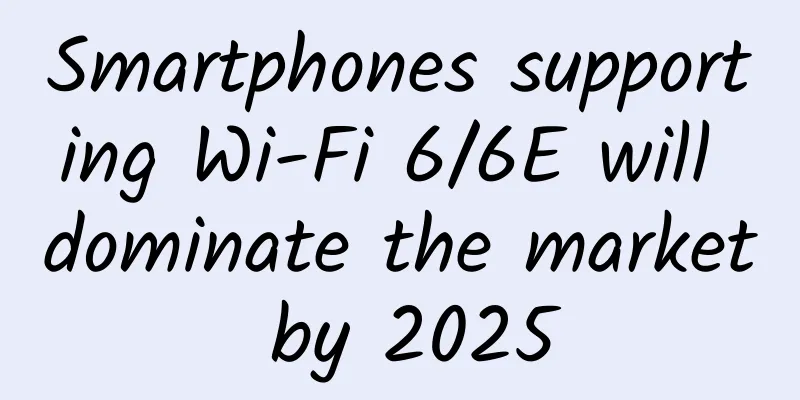Smartphones supporting Wi-Fi 6/6E will dominate the market by 2025

|
Wi-Fi 6E will be commercially available in 2021. In addition to supporting the 5GHz and 2.4GHz bands, it can also operate in the 6GHz band. According to TrendForce, Wi-Fi 6E aims to reduce network congestion and interference through more, wider, and non-overlapping channels (signal transmission channels in communication systems), while the periodic wake-up mechanism (target wake-up time) of Wi-Fi 6 and 6E effectively coordinates network traffic and maximizes the battery life of smartphones. By 2025, the market share of smartphones supporting Wi-Fi 6 and 6E is expected to exceed 80%. TrendForce further stated that the market share of Wi-Fi 6 and 6E will reach 58% in 2022, officially surpassing Wi-Fi 5 technology. This adoption is mainly due to the fact that countries such as the United States, the United Kingdom, Germany, France, South Korea, and Japan have already used the 6GHz frequency band for Wi-Fi technology, as well as the support of major mobile phone camps, iOS and Android, and the active layout of related industry chains. In addition, lower latency is driving growth in connectivity traffic as high-quality Wi-Fi in devices such as mobile phones, laptops, tablets and wireless access points requires more efficient and reliable connections, while video, telemedicine and navigation systems require greater bandwidth. In addition to more automotive, IoT and AR/VR solutions expected to enter the consumer market this year, lower latency is driving growth in connectivity traffic. At the same time, Wi-Fi technology is also expanding into commercial, industrial and home areas, with the largest growth in demand for smart homes and smart lighting. Wi-Fi-based smart home device shipments will grow at a compound annual growth rate of 18% from 2021 to 2026, connecting home devices to the core home network through Wi-Fi and promoting applications such as AR/VR, cloud gaming, 4K video conferencing and 8K streaming. The continuous development of smart home networking technology has further promoted the interconnection of smart lighting. The appeal of smart lighting lies in convenience, safety and energy saving. Currently, voice assistants such as Alexa, Cortana, Siri, etc. can be synchronized with smart lighting applications and enable voice commands to control functions such as light switches, brightness and color tone. Therefore, smart lighting can also be used outside the home in factories, offices and even outdoors. |
<<: Let’s continue to talk about what communication is?
>>: Migrating manufacturing to Industry 5.0 with 5G
Recommend
In the era of data center explosion, attention should be paid to network cabling
With the advent of the big data era, all kinds of...
5G+edge computing is in the first stage
On March 3, 2020, GSMA released the report "...
Everyone is promoting 5G products and 5G phones. Is 5G really that good? Should I choose a 4G or 5G phone?
The word 5G is "very hot". The topic of...
A thorough understanding of container network communication
Author | Chen Yunhao (Huanhe) 1. Background 1. Wh...
The Legend of Network Protocol (III): The Glorious Family Goes East and West
TCP/IP is the most widely used network protocol f...
I just pressed 666 and something magical happened to the computer...
[[394490]] There is a classic question in the com...
RAKsmart server flash sale starts from $30/month, cluster server starts from $142/month, US/Japan/Korea/Hong Kong data centers
In addition to the flash sales on VPS and cloud s...
Low-power wide-area network LPWAN: Can different factions of technology coexist?
The Internet of Things is considered to be the th...
Microsoft blocks IE10 and other older browsers from accessing official websites
Although you may have bought the genuine version ...
V5.NET launches new cloud servers with 20% discount starting from 20 yuan/month, with optional data centers in Hong Kong/Korea/Germany/Netherlands
V5 Server (V5.NET) previously mainly provided ind...
Empowering online learning, H3C University won the "Bio-Best Ecological Platform Application Award"
On November 19, 2020, the 12th CEFE China Enterpr...
Four Best Practices for Network Cable Management
If a cabling project is to be successful, you fir...
Infinitely faster than Protocol Buffers, Cap'n Proto 1.0 is finally released after ten years of open source
Cap'n Proto is an extremely fast data exchang...
This year's Internet Light Expo has upgraded its black technology: these new gadgets are quite cool
On November 6, the 5th World Internet Conference ...
MoeCloud New Year Promotion: San Jose CN2 GIA monthly payment 15% off, annual payment 30% off
MoeCloud has launched a Spring Festival promotion...









